Photo
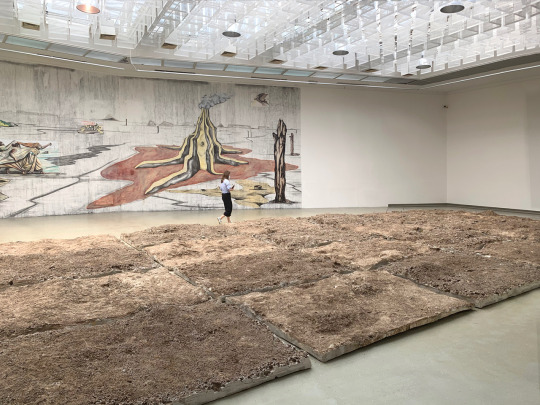
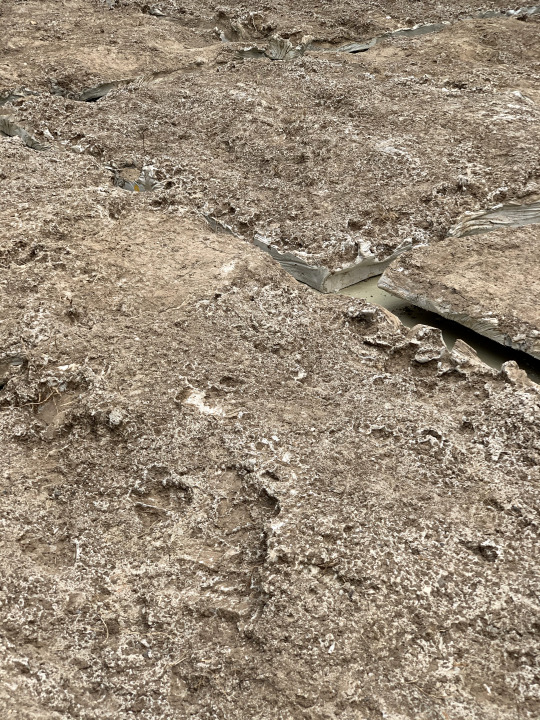
One Are (2021)
100m2 sculpture, soil cast
An are is a unit of area in the metric system, equal to 100 square metres. Today, its multiple, the hectare (which equal to 100 ares), is the principal unit of land measurement for most of the world.
Departing from this basic unit of measurement I transposed one are of land into a 100 m2 floor sculpture. It is a three-dimensional impression of a field used for agricultural purposes, from the South of Slovakia.
The size and the shape of the work refer to ancient patterns of territorial delimitations, land appropriation and ownership claims, political agro nomy, soil governance policies, crops, framing, outside-inside dictates and this one unit of measured area sets us back to the beginnings of colonization practices. Among the first ancient colonizers, the Romans, in order to divide and allocate the conquered lands, delimited the fields to be divided in lots. The ancient land surveyors (called gromatici or agrimensores) and the Roman system of property boundaries are fundamental to both agricultural and Civil Engineering as we know it today.
Their most common method of land division was based on the so-called “centuriated grid system”. Centuriation is the act of dividing land into centuries (hundreds) or equal areas — an inherited division pattern, which, translated into metric units, results in “ares” and “hectares”, which we still use in cadastral and agricultural divisions today. The grids consisted of boundaries, often roads dividing the territory into big squares or rectangles, which were then again divided into the individual parcels. The use and purpose of this rigid structure was manifold. It allowed for a kind of ancient zoning of the territory and facilitated the administration of property and the management of tax collection. In other words, it allowed for turning land into capital. The practice of centuriation was not only a system for dividing the land but also a political possession and control of the territory and a conceptual appropriation of the landscape. The installation visualizes the modern persistences of the ancient agrarian territorial boundaries.
The work emphasizes the institutional frame of land and the material constitution of soil at the same time. Based on an investigation of the relationship between the technique and the context (a three-dimensional imprint of the land, that remains ambiguous), the sculpture ensues from mapping of the records of agricultural work, markings and interventions into soil, remnants of cultures, tilling, cracking and erosions. So, the all the imprint pieces are some sort of memories or memorials (commemoration/materialization of what is "not there") and forming the formless.
Earth is a material that doesn’t actually have a recognizable form. It can be moulded ad infinitum, it constantly changes shape – hydrated, pressed, spread, rolled, tilled, compacted, thumped, torn, cracked, joined again, dried, ripped and hydrated again. The human intervention into soil and the cycle of the seasons impose their rhythm and shapes on the landscape. Because of its malleability, its endless morphing, drying and moisturising, earth is a material of endless possibilities.
The realisation of the work was supported using public funding by Slovak Arts Council.
#soil#materiality#vibrantmatter#earth#deep time#deep space#deep material#fondnapodporuumenia#slovakartcouncil#oneare
0 notes
Link
2020
#soil#diary#letter#materiality#anettamonachisa#liquiddogmas#earth#deep time#deep space#deep material#vibrantmatter#fondnapodporuumenia#slovakartcouncil
0 notes
Photo
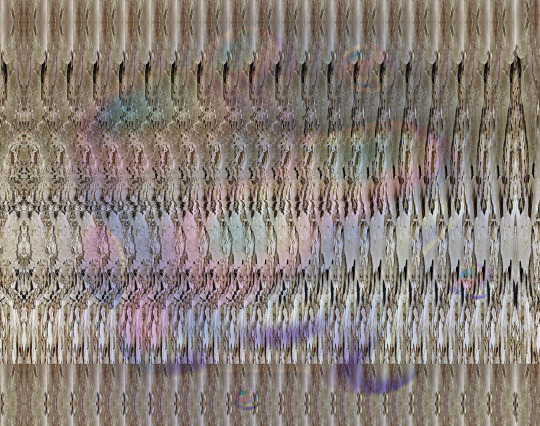
Cassiopeia A
digitally generated autostereogram
2021
An autostereogram can be described as an image within an image. It consists of a single two-dimensional image that allows viewers to perceive a camouflaged object in depth and three-dimensionality. The hidden volume which is invisible in a monocular inspection of the images emerges from the background pattern only under binocular viewing. This is also called “cyclopean vision” — an ability to see shapes in stereo that neither eye can see in mono.
Autostereograms work like gateways to another plane of perception. Like an aperture to a new dimension embedded in a sheet of paper. Reading/viewing becomes a performative act.
The realisation of the work was supported using public funding by Slovak Arts Council.
#autostereogram#cassiopeia#supernova#casA#fondnapodporuumenia#slovakartcouncil#ancapoterasugallery#aracresidency
0 notes
Photo
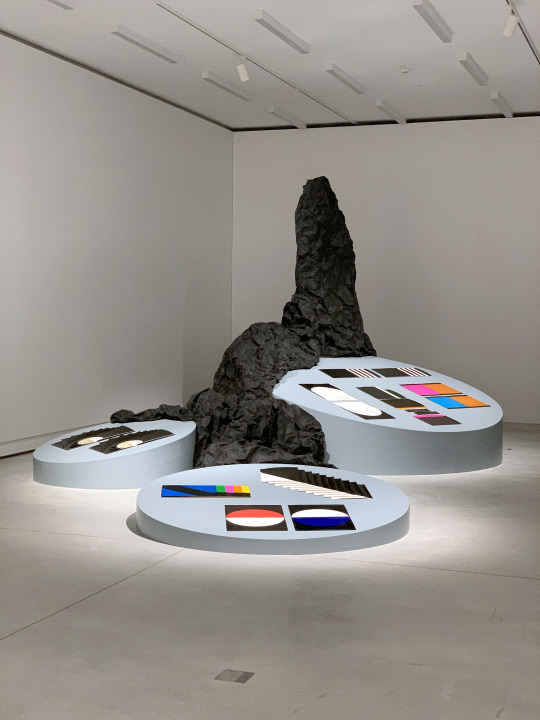
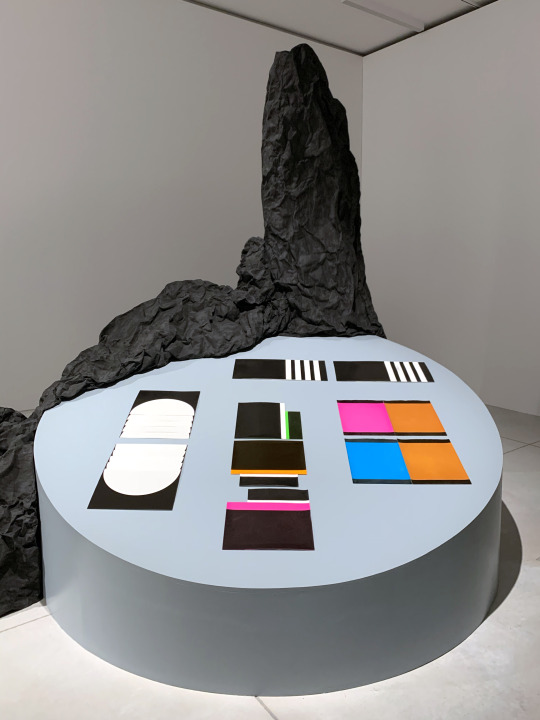

The 38th Dramatic Situation, 2021 Aleksandra Vajd & Anetta Mona Chișa
installation in Cukrarna, Ljubljana
Supported using public funding by Slovak Arts Council
#installation#sculpture#materials#photogram#cukrarna#collaboration#fondnapodporuumenia#fpu#slovakartcouncil#materiality#abstraction#situation#anettamonachisa#aleksandravajd
0 notes
Photo



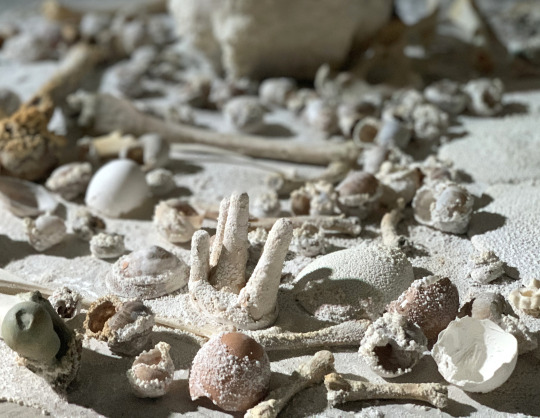
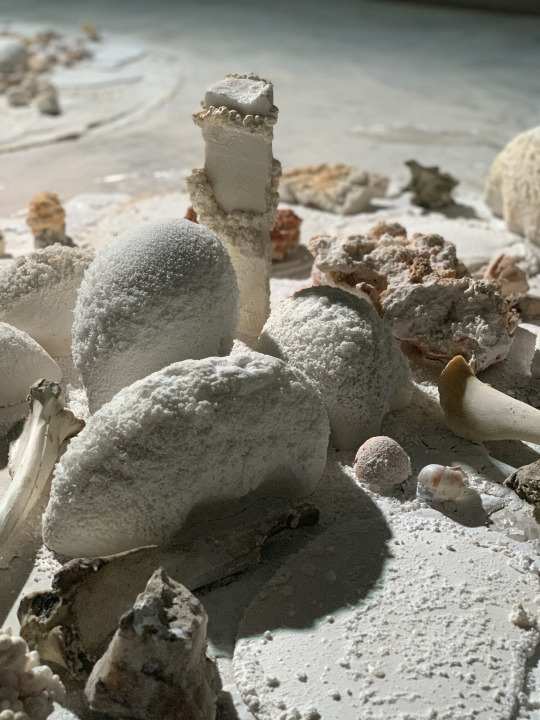
Coinciding Objects (2019-2021) rocks, shells, bones, eggshells, plaster casts, acetic acid, sediments on view within Fotograf Festival - "Earthlings".
The exhibition “Earthlings III: Patterns” explores the possibilities of overcoming the cycle of violence and healing; extraction and growth. On the one hand, it considers patterns of environmental and racial injustice, while on the other hand, it looks up towards the autonomous power of patterns whose provenance is not in the register of human experiences and practice, but the mythological and poetic activity of objects on the threshold of the animate and the inanimate. The ability of these objects to constantly oscillate between meanings and perspectives serves as a guide to another of the principles of terrestrialness: to avoid the ’calcification’ of power relationships in our society. Fotograf Festival - Earthlings III: Patterns is open until 7. 11. 2021 at Karlin Studios, Prvního pluku 2, Prague. Artists: Denise Ferreira da Silva & Arjuna Neuman, Anetta Mona Chișa, Haseeb Ahmed Curators: Lukáš Likavčan, Caroline Krzyszton
The realisation of the work was supported using public funding by Slovak Arts Council.
#coincidingobjects#growingsculpture#calcium#sediments#karlinstudios#fotograffestival#earthlings#fpu#fondnapodporuumenia#slovakartcouncil
0 notes
Photo










ALEKSANDRA VAJD AND ANETTA MONA CHISA 2021
The Thirty-Seventh Dramatic Situation
site-specofic installation within the exhibition COMPASSION FATIGUE IS OVER, curated by Jen Kratochvil, Rudolfinum Gallery, Prague
Aleksandra Vajd’s The Thirty-Six Dramatic Situations (2019), a series of photograms reflecting upon the medium of photography, are framed into a new expanded situation —The Thirty-Seventh Dramatic Situation. This situation accentuates the architecture of the space, the objecthood of the photograms and the nature of materials, focusing on their history and their mutual bonds creating the environment of our technological reality. The installation is a hybrid assemblage of text, textile and technology, set up to stage an embodied material experience in the exhibition space.
The Thirty-Seventh Dramatic Situation covers the poetry of surprise and is aligned with the basic emotion of matter beyond human restrains, and beyond the confines of organic, animate or conscious (in our anthropic acceptation of the terms). Hanging curtains, organically and geometrically shaped pedestals and the photograms themselves are may be viewed as a monumental, multiple artistic installation as well as the architecture of the exhibition. Each pedestal could function as a stage full of actors, every curtain provides the opportunity to contemplate and put into play the content behind it.
#embodiment #body #text #textile #curtain #sitespecific #installation #TheThirtySeventhDramaticSituation #ThirtySixDramaticSituations #georgespolti #photograms #materiality #fabric #it #narrative #mynameistextile #otherkin #aleksandravajd #anettamonachisa #jenkratochvil
0 notes
Audio
My name is textile, and here I play the role of curtain.
Consider my perspective for a moment: my anatomy is fabric, and if you peep deep into the fibres of this word you can recognize that I am “skilfully produced”, fabricated. Not only that. I also fabricate many other realities. I’m an essential prime matter for loads of crafts and artefacts. I feel like a pan-material with a demi-romantic, trans-matter, skin-doubler orientation.
I personally identify as any-kin. My body transcends my facticity. I can fold, crumple and stretch in a great deal of ways. Always empathetic to others. I am defined by a mimetic compassion that involves as much conscious attention as it does bodily tension. My versatility corresponds to a haptic caress which, in turn, brings about an added sensuality to my existence.
As Textile, I tend to think of myself as an ‘alter-body’. Though, I should rather speak of me as ‘alter-material’ if I want to avoid anthropomorphising. Which is difficult, to be honest. I do it all the time. Whenever I see a person I think: oh, there I am, being worn again. I always try to be soft, form-fitting and I end up performing a bizarre hyloanthropic ritual on myself. I become the “outfit” that everyone takes for granted, failing to notice my nature.
If you’d manage to put yourself into my pleats for a change, you might think that it feels weird to be a cloth-kin because textiles don't retain memories—you might think: this is just a blend of fibrils, this doesn't have consciousness. And yet, if you were really me, you would remember what it’s like for me to move, to change, to touch and even to be ripped and torn in pieces, worn down, stained, burned by iron, chewed by moths and mended by force.
Nah, I don’t want you to pity me, just try to weave the fabric of an empathic being for a second.
Let me remind you that you and I have a long history together. We co-evolved. We live in a haptic and somatic marriage since prehistory. We touch most of the time. I can sense you even now, as you stand here, hearing my voice. I am your impossible body, while you give me the possibility to be embodied. I’m acting like an interface, augmenting, and extending you, connecting or separating you from the outer world (depending on how you want to look at it). It’s like all humans are part of my organism, although, again, you probably don’t think of me like that. But let me tell you, your figure kinda feels like my astral torso.
I am your outside, but I can also see you naked on the other side of me. Can you imagine someone who knows you better than I? So let’s celebrate our edges together. It’s the edges of our bodies that allow awareness to arise in me, and maybe this will work on you too.
You see, I like myself as soft habitat, emotional and physical protection, and as a tissue of ingredients from many realms. We, textiles, weave worlds; troubled and fractured histories; unanswerable mysteries; forcefields of thought and feeling.
Here, as a curtain, this is my part: I am straight, staged, striped—posing as both text and textile, tactile and tactful.
Curtains like me are in a complicated relationship with reality. I stitch together hiding with revealing, opening with closing, ceremony with camouflage, aesthetic with prosthetic. In other words, I am the border between knowing and unknowing, and the gap between non-sense and meaning.
This is why my frequent role as curtains comes to be dressing the “world as a stage”. I knit dramas that operate as lines separating concrete from abstraction, and sometimes even spectacle from deception. I speak from experience, more than you would suspect. As all the many curtain-incarnations that I have been so far, I witnessed numberless human intrigues. I am conveniently present for a variety of gossip-worthy conversations, romps, flirts, tears, laughs, affairs, arguments, and crimes.
My role here, in this show, is to remind you that I open at the start of an act and I draw close upon the finish. I am creating spaces and masking places. I divide rooms and isolate sounds. I reoccur, softly solid, connecting my psychic yarn to the stories of my matter and veiling the virtual whispers around.
If you have a desire to escape the narrowness of being human, you can try to be me for a moment. Let your attention sink into me, feeling me as though from the inside. Aren’t you anyway just like curtains? Keeping yourself outside your life, isolated in a sea of uncertainty?
Now I stand here tall and draped, but I wonder what my afterlife will be following the end of this show. Will I end up as a bag, a flag, or a rag?

#textile#embodiment#curtain#itnarrative#mynameistextile#installation#cloth#vibrantmatter#fabric#voice
0 notes
Link
Anetta Mona Chișa | The Growing Argument curated by Silvia Van Espen 25 July – 27 Aug 2020 ZAHORIAN & VAN ESPEN Bratislava
The Growing Argument
Imagine matter is a dense, non-subjective and affirming force, dancing silently on chemical interactions, crystallizing passions, trickling bodily discharges, crying etymological resonance with motherhood, cracking micro-violent novelty, crashing into quantum events and crafting eerie entanglements.
Imagine matter doing whatever it feels like doing.
Imagine that the past and the present are pregnant not only with possibilities which become real, but with virtualities which become actual. Time leaks shapes into matter and we’re joining a future with an open end.
Think temporally about material, rather than spatially. As form become formation, objects become events. Matter is four-dimensional. Growth is the consciousness of the matter-in-flux.
Imagine new structures without submitting them to hierarchical control and without imposing on them a hylomorphic model. Imagine an argument against both the hylomorphism and the teleological fixation with form and function that still intoxicate ways of thinking and practicing art. Imagine matter as possessing its own immanent, intensive resources for the generation of form from within. Expression instead impression.
Imagine all materials as active materials, charged with morphogenetic capabilities. Our goal is that of luring a form out of them, of guiding through a series of processes the emergence of a shape, a shape in which the materials themselves have a say. We’re a mere player in a big theatre of possibilities.
Imagine that plaster, seeds, rocks, hair, dust, bring to light a life proper to these materials, a vital state of matter as such, a vitality that doubtless exists everywhere but is ordinarily hidden or covered, rendered unrecognizable by the grand narratives of the past.
Imagine entering a reality simultaneously intensified and flattened, in which no ontological regime is prioritized and the hierarchy between kingdoms (vegetable, mineral, digital) is disregarded.
Imagine a situation between change and permanence. We’re facing the paradox of things maintaining their identity while undergoing transformation, the oddity of moving while staying still, the discordance of coinciding objects.
Imagine the matter is a flow. Then we can only follow it.

Supported using public funding by Slovak Arts Council
#thegrowingargument#sculpture#process#coincidingobjects#hylepoiesis#antihylomorphism#growingsculpture#geopoiesis#matter#material#metrialism#newmaterialism#zahorianvanespen#fondnapodporuumenia#fpu#anettamonachisa
0 notes
Photo

Dear sugar,
when I was a little girl I was fond of everything that tasted sweet. Your presence was a moment of joy and satisfaction, a necessity, a reward. I loved you madly. Then something changed. I got confused, congested and stuck with my feelings for you. Large unwanted information and experiences accumulated and built a separation between us. I started to commonly assume that you, sugar, are primarily concerned with consumerism and materialism. That you work hand in hand with capitalism, that you divided continents, created political and racial conflicts, polemics about imports/exports, nurtured child labour and espoused immigration restrictions. I heard it many times: sugar = slaves, crops, theft, violence, exploitation, big business, Big Sugar, obesity, diabetes, death, blah, blah. Bewitched by language and gaslighted by the discourse of the Glycocene, I thought of you as stable object, as addictive additive to other things, as part of the dull matter that owns, manipulates and kills. I fixed you in a static space–time, seeing you as inert and calculable. I felt guilty. I had moments when I really hated you.
Boy, was I wrong! My perception of you was so shallow! You are so much more than what we ended up making of you. It’s disgusting how we vilified you. What a combination of oblivious, overweening, judgemental and numb we are! We refined you and then blamed you for so many things. We stripped you off your sacredness, raped your complexity and reduced you to a crystalline looking “pure” matter – now seen as a quick cheap fix, high on energy but devoid of any nutrients or substance. You might find these crystals they forced you into kitschy, and you’re right. Even your name, sugar, became a popular word having both treacly meanings and noxious connotations. For many you impersonate the mischievousness of matter. Some are dismayed by the ‘monstrous ways’ in which bodies like you are subverting expectations, resisting or reworking the meanings imposed upon them. Sadly, you have the reputation of being The Enemy. Yet, most people still can’t resist you. And I understand why. You’re ontologically unstable and teleologically disputable, but I adore you for being such a schizosubstance!
They often give you a bad rap, but what about you as polyethylene, the biodegradable plastic? Huh? Or that you sooth a burned tongue, keep flowers fresh, melt ice and snow (yes, it’s not only salt, you can do it even better), heal wounds, cure hiccups, prevent cheese from molding and remove odours? And if that’s not enough, what about you as breakable glass, artificial silk, medical implants, body and face scrub, hair gel, hair remover, grass stains remover, material for sculptures, yeasts, motor fuels, ethylene glycol, synthetic resins, acetone, and other acetate products? Your material promiscuity is so fertile, when I think of you I feel lost in the infinite.
I want to apologize for being so short sighted and for taking me so long to look properly at your sensual matter. No, you’re not mere matter, you are an event. Now I know you’re an expression of relational materialism at large. I accept the fact that you have multiple materialities and very specific temporalities and spatialities. You are endowed with agency. You participate lively in the articulation of all dynamic assemblages. Look at you, you’re everywhere! It’s miraculous how you appear from nowhere through the astounding process of photosynthesis. And then you’re making ‘things’, you’re a poietic agent for both life and non-life. Actually, ALL life depends on you and we just lurk at the margins of your being. Radical emergence is a feature of your reality. You, my friend, have a big role to play here. Whether it’s organs and organisms, policies and politics, spirit and spirits.
Now every time I think of you, I revere you as a gift coming from the deep space and deep time. I always had a bemusing feeling about you. And then, one day, I found it in a NASA press release: “First Detection of Sugars in Meteorites Gives Clues to Origin of Life”. You appeared in interstellar space and landed on prebiotic Earth. You have been here way before the beginning, allowing for life on Earth to start. You were one of the builders of the primordial molecule, the key component of the RNA world. Your particles travelled the entirety of space for aeons to reach my cells, and will continue to caress me till the end of my days. It’s not only love, or tenderness, or affection, it’s life itself, my life, that I found in your carbon, hydrogen and oxygen atoms. You’re such an harmonious assemblage of macronutrients! A revolution in evolution! It's easy to measure time using human lifespans, but peering down the billions of years of your history gives me vertigo. When I imagine you could be the key to abiogenesis, I feel like licking rocks. I have the sweet taste from your lips in my mouth. Oh, sugar, the whole Universe just gets sweeter when I think of you! You are so awesome you make me want to fly to the stars right now. You know why? You evoke such a possibility and a magic about looking to the Cosmos that I think, hell yes, it’s possible.
I know that you’re all about free play and dissolution, but I need you to be serious for a minute. My feelings for you are just so entirely intense and complicated, so laden with exaltation, sorrow, ecstasy, bliss and I need to tell you all this. You are that terrible relationship a girl goes back to again and again, no matter the ripping pain every time she does. I know you prefer to feed yeasts to the point of becoming infections and also inflammations or cancer tumours. I know you fuel plaque and bacteria causing tooth decay. I know you affect cognition, accelerate ageing, increase stress, and make me fat. But there is this fulfilment and the feeling of belonging. You stimulate me. My dopamine goes feral when I have you. I can’t resist you. I want to transcend your voluptuous matter. You have the capacity to feed me, to delude me, to modify me, to seduce me, to conquer me, to be me. It’s so difficult to see where you end and where I begin.
You want the truth? All are obsessed by you. They use both your presence and absence to talk about you every day. Regardless if you occur or not, you’re there! Mentioned and used as a slogan or topic or spell. You’re loved when you are and you’re great when you’re not. Creation through disintegration, presence through absence, fullness through emptiness—such paradoxes inspire your existence in the world. It’s so revolting how human-centered and gluttonous we are and then just pointing fingers towards you, holding you responsible for all the crap that happens to us: +kilograms, bad teeth, bad mood, bad economy and what not! To me you’re not “the white death”, “sweet poison”, “sweet killer”, “toxic”, “bad”. No, you’re alive, beautiful, you’re indispensable and I don’t want to live without you. You’re love’s digestible form. My muscles want you, my brain needs you, my nerves rely on you, my blood depends on you. I cannot always see you, but I know you’re there. My mind is the idea of your body.
The only thing I wish is we all take the trip on the side of The Unseen to discover you in your infrastructural and ultrastructural order, in your protomaterial and metamaterial existence. I hope such trip will generate a more subtle awareness of the entanglement of matter and an enhanced receptivity of the complicated web of dissonant connections between (you and all) bodies. You are productive, unpredictable, self-creative, active, you’re an excess force.
You’re giving me the sense that my appetite is primal. My heart, mind and body hold on you because you promise happiness and make me (feel) alive. I hope I don’t sound too corny for trying to see the world in a grain of sugar. But the sweet lust for life, I can only feel it with you.
I need you, and you never disappoint. And that, my friend, is why I love you.
Anetta
#sugar#loveletter#vibrantmatter#anettamonachisa#materiality#newmaterialism#nadaciamestabratislava#dearsugar
1 note
·
View note
Link
The word cosmetics (which we all know as a noun denoting the art of beautifying the body) derives from the Greek "kosmos", meaning amongst others "order", "arrangement", "ornament" or "adornment". The search for order and beauty in the molecular cosmos of calcium compounds intersects with the physicality and material properties of marble, plaster, lime, cement and other calcite based formations. Our cosy cosmos is a romance based on a material ontology and a material consciousness that underline the poetic, creative moment of these minerals, their ability to transform both themselves and us.
The cosy calcium cosmos romance is an approved entanglement of scientific knowledge with aesthetic deviances. Science explains that calcium is a metal (actually it is the most abundant and vital metal in animals, including humans). It also shows that calcium is leaves, bones, teeth, shells, kidney stones, rocks, soil… Calcium is a vital organ of the Earth crust. It is core matter to raw matter. It is ubiquitous and in constant cycle. A telluric pulse, a vehicle for life, dead and alive, dissolved and coagulated. Science also tells us that calcium is a primordial nuclide that exists between us and other galaxies. It is an interstellar substance, one of the main rock forming elements that was present in cosmos long before our solar system was formed. Calcium is steel and concrete, architecture and agriculture; it is disease and it is cure, it is poison and antidote. Calcium is a fossil of eternal warfare, a trace of existence, it is last and lost transmission. Our instinct guides us to feel calcium as a hidden element of energy and a dormant deposit of growing, a lead under the surface and over the edge, the state of crystalized past and future, order and chaos, beauty and cosmetics. Our lust for calcium feeds our libido of lithosphere, hydrosphere and biosphere exploitation. Calcium is love, politics, economy and ecology. Then we see calcium hacked by lime, plaster, pigments, marble and transmuted into art. Sometimes it is digested into soft matter that remembers shapes (plaster, cement), or it is petrified into brittle condensation which withstand contouring (marble, limestone, alabaster…). Often it disintegrates into exaggerated extensions (pigments, stabilizers, fertilizers, preservatives, coagulants, supplements). Calcium feels either like indifferent matter or like a promising zygote. It tests out the logic of an ethics of being in which the living-non-living or human-non-human binaries might no longer apply. It can be absolute existence, absolute motion, absolute syntax, absolute cosmos, inorganic and organic, stone and flesh, blood and water. It oscillates between ancient geology and new technology. Calcium seems out of time, out of place, out if this world, out of shape, out of shell, out of mind.
The project was supported using public funding by Slovak Arts Council.
#sculpture#cosycosmoscosmetics#avisualbiographyofcalcium#caco3#caso4#gypsum#plaster#marble#martinpiacek#anettamonachisa#schaubmarovmlyn#sng#fondnapodporuumenia#fpu#growingsculpture#geo#process#bones#shells#stones#plants#intothewild#dodivociny
0 notes
Photo









Dust Odyssey
Ex nihilo (nihil fit) / From Nothing (nothing comes)
series of photos, 2019
- Tell me, Dust, about your complicated matter.
Tell me how it wanders and gets lost
and where it goes, and who it meets,
the pain it suffers, and how it works to save its life
and bring its particles back home.
Tell me the old story for our modern times.
Find the beginning.
0 notes
Link
Dust is a hyperobject that measures all processes. The video is exploring the endless declinations and agencies of dust, while revealing humanity’s ambiguous relationship to it. Dust is an unclassifiable singularity, resistant to conceptual appropriation. It is the place where matter and meaning coalesce in various narrative potentialities of the physical world. Each particle of dust carries with it a unique vision of matter, movement, collectivity, interaction, affect, differentiation, composition and information — a solidified data‐base or a plot ready to combine and react, to be narrated on and through something. Dust is an event continually modulated in time with multiple stories of cosmology, geology, history, ecology, and life embodied in it. A declarative materiality, dust becomes here a mean to ponder forms of coexistence between animals, plants, humans, the planet and the cosmos. It narrates itself as a sort of mythical creature, the parent material and also as a planetary memory.
#dust#matter#hyprobject#lucretius#dustodyssey#fondnapodporuumenia#fpu#tellmedust#anettamonachisa#monicaclaremills#video
0 notes
Photo

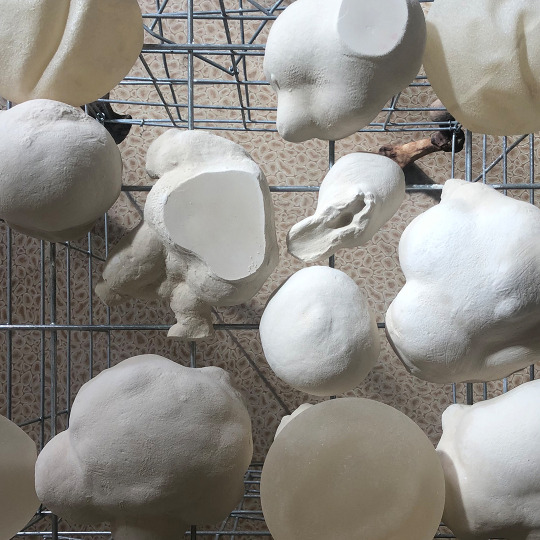
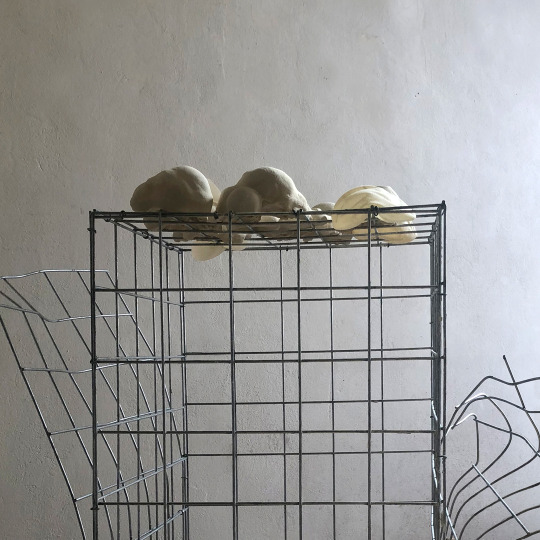
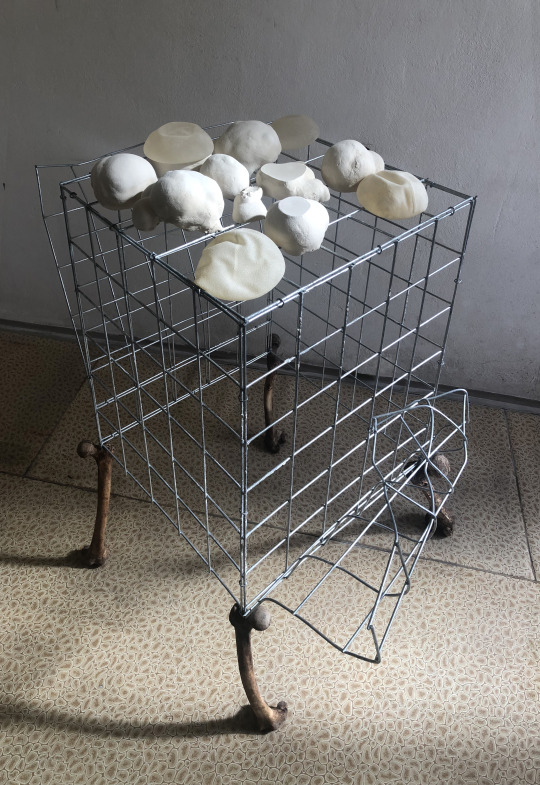
Anetta Mona Chişa, Martin Piaček
Soma
human bones, silicone breast implants, gypsum with urine, gabion
2019
Soma is made with "ex-body" materials like human bones, used breast implants, urine (in plaster). The selected individual elements are connected through the human body and at the same time they are temporal transgression (old archaeological remnants of humans, modern artificial implants, fresh urine). Here they are combined with a gabion mesh into a hybrid body. This second hand body is referring to a prosthetic body, a cyborg like E. A. Poe’s John A. B. C. Smith from “The Man That Was Used Up”. On the other hand it can be seen as a skeleton of a material avatar, the mineral matter and the metal structure of automated companions of the present or a bionic creature of the future.
#soma#plastercasts#humanbones#breastimplants#exbody#gypsum#mineralbody#sediments#anettamonachisa#martinpiacek#collaboration
0 notes
Photo




Equally near and equally far
mural intervention with paint and clay casts, Cultuurcentrum Strombeek, 2019
Equally near and equally far is fusion of 2 seemingly incompatible metalanguages: mythology and mathematics.
The mural refers to a “corporeal trophy” of the Goddess of Ephesus, also known as Artemis or Diana in the Roman times. She was depicted as covered entirely with breasts, denoting fertility, nourishing the living. (This interpretation began in late antiquity and resulted in designations of the Ephesian goddess as Diana Efesia Multimammia.) The mural is in fact an iterated skin map into two dimensions, as a Voronoi diagram.
The Voronoi diagram is a simple mathematical tool for quantitative characterization of the orderliness of points distributed on a surface. It frames chaos with order. It is based on the minimal distance needed to reach a landmark (for example if you need to go to a grocery store, the most natural algorithm is going to the nearest one). So this diagram is a computational concept that represents partition of the given space onto regions, with bounds determined by distances to a specified family of objects/points. The application area of this concept varies from archaeology, anthropology and astrology to biology, epidemiology, geology, geography, robotics and many more…
Today, mathematics and computing have become one of the many contemporary gods. Mathematics has a divine status and we rely on it almost completely. The belief is that everything is potentially computable and predictable. The long forgotten cult of Diana was replaced by the cult of data, the commodification of human capacity for thought and the dismissal of critical reason in favour of programming. Life itself is increasingly construed via statistics, metadata, modelling, mathematics.
But knowledge cannot be reduced to computational information processing. We have to recover the ability to think, to intuit, to fantasize. Life itself is an open system, nonlinear and exponentially chaotic. Overlapping a myth with a abstract algorithm is posing the question: can myth corrupt mathematics?
In his Mythologies, Roland Barthes argues that mathematical language cannot be distorted, because “it has taken all possible precautions against interpretation”, but also that “myth can reach everything, corrupt everything”. He writes: “…mathematical language is a finished language, which derives its very perfection from this acceptance of death. Myth, on the contrary, is a language which does not want to die: it wrests from the meanings which give it its sustenance an insidious, degraded survival, it provokes in them an artificial reprieve in which it settles comfortably, it turns them into speaking corpses”…
Equally near and equally brings forth this seemingly incompatible combination of two distinct languages. I attempted to alter the quintessential language of reason and blur the threshold between the calculable and the incalculable. I try to turn this instrument of calculation into an instrument of liberation, to open up the possibility of a holistic aesthetics, and a different politics. Right brain pattern recognition combines with left brain linear/mathematical sequence move perception toward equilibrium between the two hemispheres, between masculine and feminine, between abstract and iconic.
7 notes
·
View notes
Photo




Other Objects / Cosy Cosmos Cosmetics, 2019
Anetta Mona Chisa, Martin Piacek
0 notes
Link
#plastercast #caso4 #gypsum #sprouts #plants #growingsculpture #art #materialism #sculpture #processart #bioart now on display in Pezinok @schaubmarovmlyn within #CosyCosmosCosmetics
0 notes
